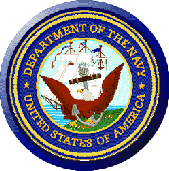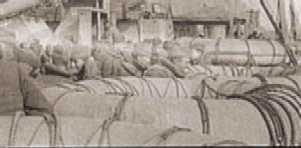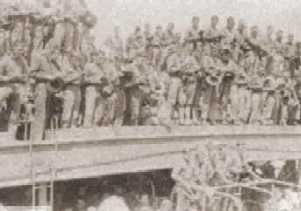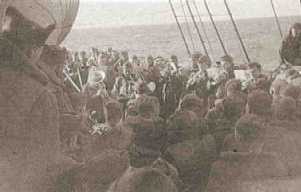The Story of the American Expeditionary Forces |

|
SEALIFT
|


The U.S.S. Leviathan Departs for France

SEALIFT FOR THE AEFBy Walter KudlickMore than 2 million American soldiers and 7.5 million tons of cargo were transported to France during the nineteen months the United States was involved in World War I. The initial challenge America faced was to find the ships to move a huge army and its supplies across the Atlantic. Click here to see a month-by-month summary of the troops and cargos shipped to France The Transport FleetA start was made by chartering a few U.S. Flag ships and by July, 1917 there were in service seven troop ships and six cargo ships with a total dead weight capacity of 94,000 tons. From this small beginning came a great transport fleet which totaled almost 3.25 million tons of shipping by the end of 1918. The tonnage was distributed 0.66 million deadweight tons for troops and 2.57 million tons for cargo. A significant portion of this fleet was made up of seized German ships, which came into service in the Fall of 1917. The U.S.S. Leviathan pictured above was formerly the German liner Vaterland. Dutch, Scandinavian and Japanese tonnages also helped swell the fleet, as did the nearly one million tons of new ships turned out by the Emergency Fleet Corporation  U.S.S Mt. Vernon and CrewSources of Shipping While the cargo fleet was almost exclusively U.S. Flag, ships of various nations were used to transport the American troops. Click here to see a summary list of the nations providing ships for the AEF. Cargo MovementThe first shipment of cargo to support the AEF was made in June, 1917, and amounted to 16.000 tons. By the last month of the war, this figure had grown this had grown to over 800,000 tons.  U.S.S Yale Takes on Cargo [Pre-War Photo}Click here to see a table of the cargo shipped for various military supply services. Troop Sealift Between the United States and FranceThe Doughboys left principally from 6 U.S. ports and 4 Canadian with New York (including Hoboken and Brooklyn) handling more than three-quarters of the the men. European ports of arrival were even more numerous than those of the embarkation from North America. Liverpool, with 884,000 men arriving, was the single busiest port, with Brest, where 791,000 Americans landed, in second place. The arrivals were almost equally divided between France and England. Ship Board Scenes
The table accessible below shows the number of men sailing for France and for home by month. (The data for the first six months is approximate.) Although it is incomplete with respect to the homeward travel and minor volumes in the in the reverse direction are not shown, the table does illustrate the monthly buildup. Click here to see listings of the troop traffic at various ports used by the AEF |

Doughboys Arriving at St. Nazaire
|
Sources and thanks:
The data used above was extracted from the WAR WITH
GERMANY - A STATISTICAL SUMMARY, by Leonard P.
Ayres, Washington, D.C., Government Printing Office, 1919. |
To find other Doughboy Features visit our |
Membership Information  Click on Icon |
For further information on the events of 1914-1918
visit the homepage of |
Michael E. Hanlon (medwardh@hotmail.com) regarding content,
or toMike Iavarone (mikei01@execpc.com) regarding form and function.
Original artwork & copy; © 1998-2000, The Great War Society


